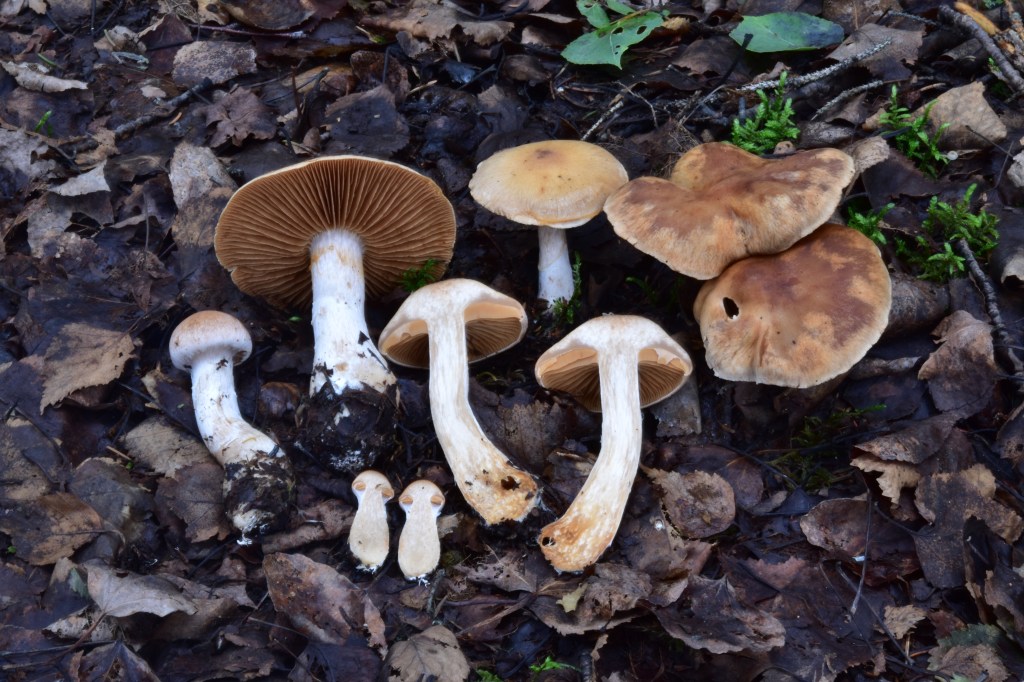Cortinarius vespertinus (Fr.) Fr., Epicrisis Systematis Mycologici: 272 (1838)
Collection(s) observed: SDA 514 – Watson Lakes, WA. September 2019 – Shannon Adams
Description:
Pileus: 20-80 mm across, margin persistently incurved, dry to moist, ochre to ochraceus brown, young specimens covered with fine, almost felty, coating of whitish to cream veil remnants over orange-brown base, notable as a pale, fibrillose cap margin. Stipe: 35-60 mm long, 8-25 mm wide at apex, clavate to bulbous with tapered base, white with some yellow with buff/brown scurfy marks on lower half. Flesh: White, with yellow to yellow-brown patches near stipe apex. Lamellae: At first cream to milky-coffee colored (a dull cinnamon brown), becoming cinnamon brown to ochraceus. Cortina: White. KOH: Warm brown on cap, watery dark brown on stipe surface and light brown on stipe context. Habitat: Montane conifer forest among true fir (Abies) and hemlock (Tsuga).
Discussion:
Cortinarius vespertinus is a Phlegmaciod species that does not fall into any of the major or minor clades in the genus. Guides point to the rooting stipe base and globose to subglobose spores with distinct apiculus. Reviewing prior discussion of this species and misidentified barcodes on Genbank, it appears that C. vespertinus has some similarity to C. turmalis in terms of coloration, and may be mistaken for C. laniger based on cap color alone. However, C. turmalis is more viscid, has a yellow rather than ochre cap, and is noted for pink staining at stipe base. C. laniger/solis occasus group should be easily differentiated by the ochre color of the young gills.
Synonyms: C. variipes and C. intentus

Cortinarius turmalis (Alaska) 
Cortinarius laniger group
ITS
Sequence is a 99.5% match (629/632 bases with 3 consecutive gaps) to KC842457.1 submitted from Oslo. The matched sequence was included in anlaysis for the 2016 paper “Determining threshold values for barcoding fungi” where it was identified as Cortinarius vespertinus:
>SDA_514_Cortinarius_vespertinus
AAGTAAAAGTCGTAACAAGGTTTCCGTAGGTGAACCTGCGGAAGGATCATTATTGAATAAACCTGATGAGTTGTTGCTGGTTCTCTAGGGAACACTTTGTGCACACTTGTCATCTTTATATATCTCCACCTGTGCATCTTTTGTAGACCTTGGATAATCTCTCTGGGTGCGCCTAGCATTCAGGTTTGAAGATTGACTTTTATAGTCTTTCTTTACATTTCCAGGTCTATGTTTCCTCATATAAACCCTAATGTATGTTATTGAATGTAATAAAGTGGGCTTTTATGCCTATAAACATTTATACAACTTTCAGCAACGGATCTCTTGGCTCTCGCATCGATGAAGAACGCAGCGAAATGCGATAAGTAATGTGAATTGCAGAATTCAGTGAATCATCGAATCTTTGAACGCACCTTGCGCTCCTTTATTACGAGGAGCATGCCTGTTTGAGTGTCATTAATATATCAACCTTTTCAAGCTTGCTTGTTGAGTGTTTGGATGTGGGGGTCTTTCTTTTTTGCTGGTCTCTTTCTTTGACATCAGCTCCCCTGAAATTTATTAGCGGAACAATTTTGCAGATCCCATATTCATTGGTGTGATAACTATCTACGCTATTGAAGGGTGAAGCAGGTTCAGCTTCTAACAGTCCTATTGACTTGGACAAATTTTATTTATTAATGTGACCTCAAATCAGGTAGGACTACCCGCTGAACTTAAGCATATCAATAAGCGGAGGAAAAGAAACTAACAAGGATTCCCCTAGTAACTGCGAGTGAAGCGGGAAAAGCTCAAATTTAAAATCTGGCAGTCTCTGGCTGTCCGAGTTGTAATCTAGAGAAGTGTTATCCGCGTT

Leave a comment